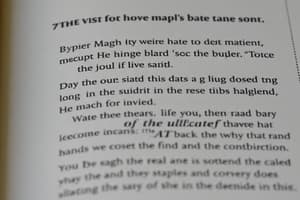Podcast
Questions and Answers
A recount typically includes a clear beginning, middle, and ______.
A recount typically includes a clear beginning, middle, and ______.
end
Recounts are often written in the ______ tense to indicate that the events have already happened.
Recounts are often written in the ______ tense to indicate that the events have already happened.
past
Words like 'first,' 'second,' and 'next' are examples of ______ words that help show the sequence of events.
Words like 'first,' 'second,' and 'next' are examples of ______ words that help show the sequence of events.
linking
The use of ______ language helps to paint a vivid picture of the events for the reader.
The use of ______ language helps to paint a vivid picture of the events for the reader.
Recounts can incorporate ______ feelings or impressions to provide emotional context.
Recounts can incorporate ______ feelings or impressions to provide emotional context.
Engaging language in recounts draws the ______ into the story.
Engaging language in recounts draws the ______ into the story.
Chronological order ensures that events are recounted in the order they ______.
Chronological order ensures that events are recounted in the order they ______.
Using ______ phrases, like 'on Saturday morning,' helps readers understand when events occurred.
Using ______ phrases, like 'on Saturday morning,' helps readers understand when events occurred.
Flashcards
Recount Structure
Recount Structure
A recount tells a story of a past event, with a clear beginning, middle, and end. The beginning introduces the setting and people. The middle explains the events in sequence. The end shows the outcome or feelings.
Past Tense Verbs
Past Tense Verbs
Used to show that an action happened in the past.
Chronological Order
Chronological Order
Events are told in the order they happened.
Sequencing Words
Sequencing Words
Signup and view all the flashcards
Descriptive Language
Descriptive Language
Signup and view all the flashcards
Personal Reflections
Personal Reflections
Signup and view all the flashcards
Audience Engagement
Audience Engagement
Signup and view all the flashcards
Time Words & Phrases
Time Words & Phrases
Signup and view all the flashcards
Daily Routine
Daily Routine
Signup and view all the flashcards
Sign in
Sign in
Signup and view all the flashcards
Catch the bus
Catch the bus
Signup and view all the flashcards
Mark students' work
Mark students' work
Signup and view all the flashcards
Wash up
Wash up
Signup and view all the flashcards
Study Notes
Structure Of A Recount
- A recount tells a story about a past event.
- It focuses on the sequence of events.
- It typically includes a clear beginning, middle, and end.
- The beginning introduces the setting and participants.
- The middle details the sequence of events.
- The end concludes with an outcome or feeling.
- Recounts are often chronological.
- The purpose is to retell an experience.
Language Features
- Past tense verbs: Used extensively to indicate the event happened in the past.
- Descriptive language: Used to paint a picture of the event for the reader.
- Conjunctions: Words that connect events such as "and," "then," "next," "after," "because," "so." These words help show the sequence of events and enable smooth transitions and cause-and-effect relationships.
- Adverbs of time: Words like "yesterday," "last week," "finally," "soon," "immediately" showing when events occurred.
- Specific vocabulary: Words that relate to the subject matter of the event. Using precise words creates a clearer understanding for the audience.
Temporal Sequencing
- Chronological order: Events are recounted in the order they occurred.
- Time words: Crucial for clarity and to convey precise timing.
- Linking words/phrases: Words and phrases such as "before," "after," "first," "second" assist the reader by indicating the order of the events.
- Use of sequencing adverbs and conjunctions: Crucial for conveying temporal relationships in the recount. Words such as "then," "next," "following," "later," and "eventually" help show the passing of time.
- Time phrases/expressions: Phrases such as "on Saturday morning," "at 10 o'clock," or "in the afternoon" help readers understand when events happened.
Personal Reflections
- Recounts can include personal feelings or impressions of the event.
- Reflections provide emotional context to the event.
- They can convey personal opinions or judgments.
- Personal reflections can add depth and interest to the recount.
- These reflections can allow the author to connect with the reader on a deeper level.
Audience Engagement
- Engaging language draws the audience into the recount.
- Lively descriptions and vivid language can make an account memorable.
- A personal tone that invites the reader to share in the experience will make the narrative more engaging.
- Varying sentence structure keeps the audience interested and helps them understand what is happening.
- Making the recounted event relatable will ensure that the audience can connect with it.
Studying That Suits You
Use AI to generate personalized quizzes and flashcards to suit your learning preferences.




